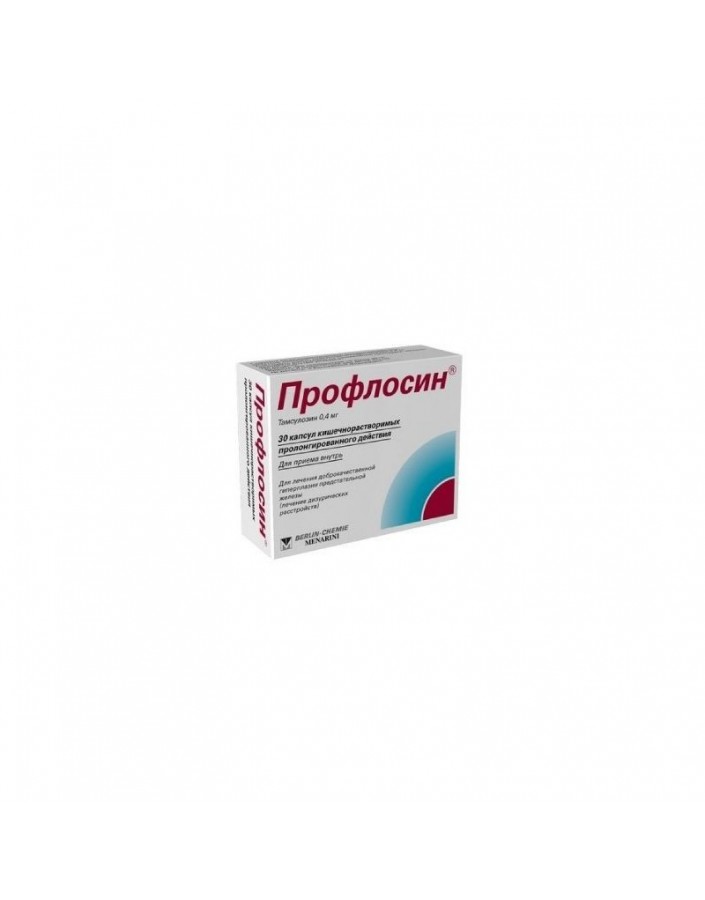




Security policy (edit with Customer reassurance module)

Delivery policy (edit with Customer reassurance module)

Return policy (edit with Customer reassurance module)
Indications for use
Benign prostatic hyperplasia (treatment of dysuric disorders).
hypersensitivity to Tamsulosin or other components of the drug; orthostatic hypotension (including a history); severe liver failure. With caution chronic renal failure (creatinine clearance less than 10 ml / min); arterial hypotension.
Dosage and administration
Inside, 1 capsule 1 time per day after breakfast or the first meal. The capsule should be swallowed whole, without chewing, drinking plenty of water. The capsule can not be divided into parts or broken, as this may affect the rate of release of the active substance. The duration of use is not limited.
Pharmacodynamics
Tamsulosin selectively and competitively blocks postsynaptic α1A-adrenoreceptors that are in the smooth muscles of the prostate gland, bladder neck and prostatic urethra. This leads to a decrease in the smooth muscle tone of the prostate gland, the bladder neck, the prostatic part of the urethra and the improvement of urine flow. Α-adrenoreceptor blockers can lower blood pressure (BP) by reducing peripheral vascular resistance.However, in clinical trials with tamsulosin, in patients with a normal level of blood pressure, there was no clinically significant decrease in blood pressure.
Pharmacokinetics
Suction
After oral administration, tamsulosin is rapidly and almost completely absorbed from the gastrointestinal tract. Tamsulosin absorption slows down somewhat after eating. After a single dose of the drug is taken orally at a dose of 0.4 mg, the maximum concentration (Cmax) of tamsulosin in the blood plasma is reached in approximately 6 hours. Distribution
Communication with plasma proteins is about 99%, the volume of distribution is small - 0.2 l / kg. Metabolism
Tamsulosin is not exposed to the “first pass” effect and is slowly metabolized in the liver to form less active metabolites. Most tamsulosin is present in the blood in unchanged form. The experiment revealed the ability of tamsulosin to slightly induce the activity of microsomal liver enzymes. Removal
Tamsulosin and its metabolites are mainly excreted in the urine, 9% of the drug is excreted unchanged. The half-life (T½) of tamsulosin is approximately 10 hours (with a single dose after a meal), with a regular dose of 13 hours.
Possible side effects when using the drug are listed below in descending frequency of occurrence: often (<1/10,> 1/100), infrequently (<1/100,> 1/1000), rarely (<1/1000,> 1/10000 ), very rarely (<1/10000), including individual messages.Nervous system disorders: often - dizziness; infrequently - headache; rarely - fainting. Violations of the cardiovascular system: infrequently - tachycardia, orthostatic hypotension. Disorders of the gastrointestinal tract: infrequently - constipation, diarrhea, nausea, vomiting. Reproductive system disorders: infrequently, impaired ejaculation; very rarely - priapism. Violations of the skin and subcutaneous tissues: rarely - rash, pruritus, urticaria; rarely - angioedema.
Other: in some cases - the development of atonic iris syndrome (narrow pupil syndrome) during cataract surgery, asthenia, rhinitis.
Carefully
At the first signs of orthostatic hypotension (dizziness, weakness), the patient should be seated or laid. Before starting therapy with Proflosin, the patient should be excluded from diseases and conditions that can cause symptoms similar to those with benign prostatic hyperplasia. Before treatment, and regularly during therapy, a digital rectal examination should be performed and, if necessary, determination of the concentration of a specific prostate antigen (PSA).In the case of the development of angioedema, treatment with Proflosin should be immediately discontinued. Re-appointment of the drug is contraindicated. With surgery for cataracts in the presence of the drug may develop atonic iris syndrome, which must be considered a surgeon for the preoperative preparation of the patient and during the operation. Impact on the ability to drive a vehicle and other complex mechanisms Care should be taken when driving vehicles and occupations of potentially hazardous activities requiring increased concentration of attention and speed of psychomotor reactions, due to the fact that dizziness may develop.
Cases of overdose while taking the drug to date has not been observed. However, theoretically, there is a possibility of a sharp decrease in blood pressure and tachycardia, which may require appropriate measures. To restore blood pressure (including with orthostatic hypotension) and heart rate to normal values of the patient must be laid. Hemodialysis is not appropriate because tamsulosin has a high affinity for plasma proteins. To prevent further absorption of tamsulosin, it is advisable to wash the stomach, take Activated carbon or osmotic laxative (for example, sodium sulfate).
Interaction with other drugs
Tamsulosin does not interact with Atenolol, Enalapril, Nifedipine, and theophylline. With simultaneous use with cimetidine, a slight increase in plasma tamsulosin concentration was noted; with Furosemide, a decrease in concentration, but this does not require adjusting the dose of Proflosin — since the concentration of the drug remains within the normal range. Diclofenac and Warfarin may increase the rate of elimination of tamsulosin. The simultaneous appointment of tamsulosin with other α1-adrenoreceptor blockers can lead to a decrease in blood pressure.
Release form
Capsules enteric soluble prolonged action, 0.4 mg. On 10 capsules in the blister from PVC / PE / PVDH and aluminum foil. On 1, 3 or 10 blisters together with the instruction for a medical use place in a cardboard pack.
Storage conditions
At a temperature not higher than 30 ° C. Keep out of the reach of children!
Shelf life
Do not use after the expiration date printed on the package.